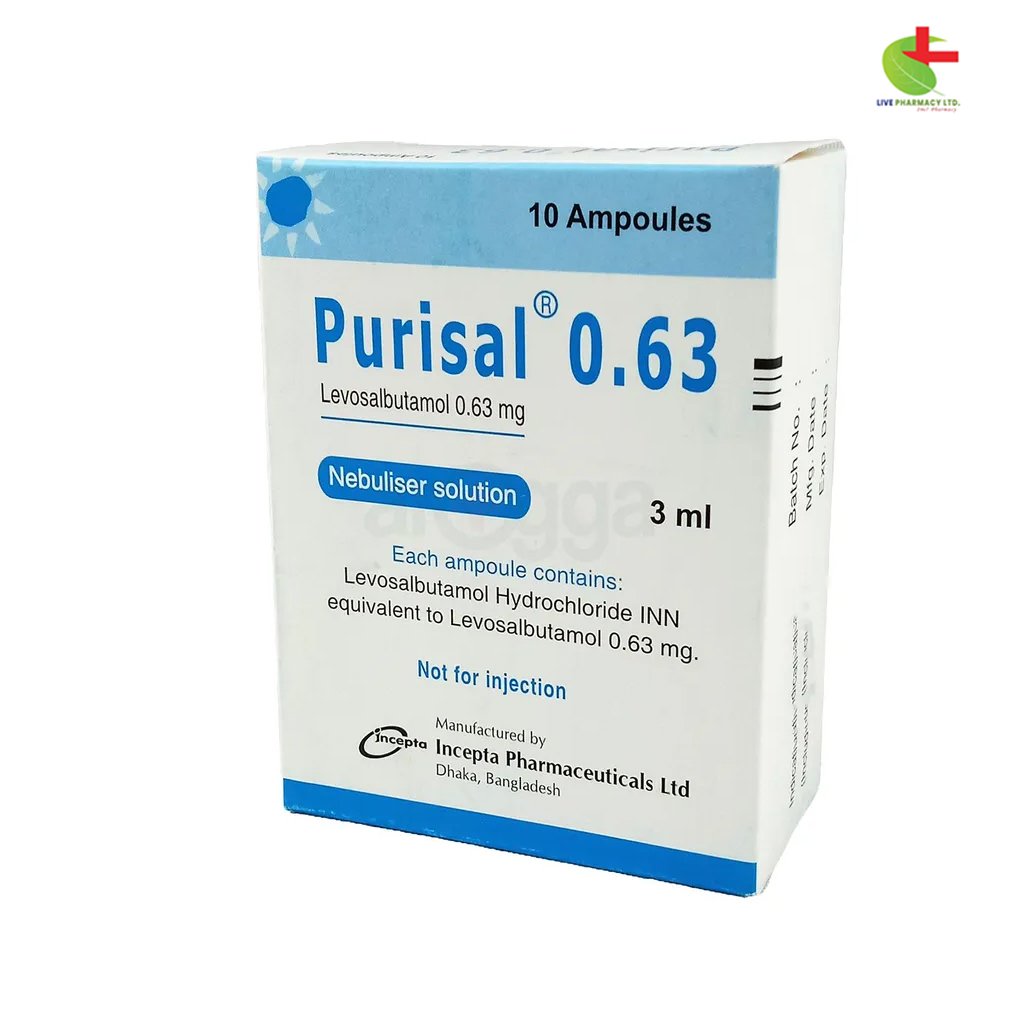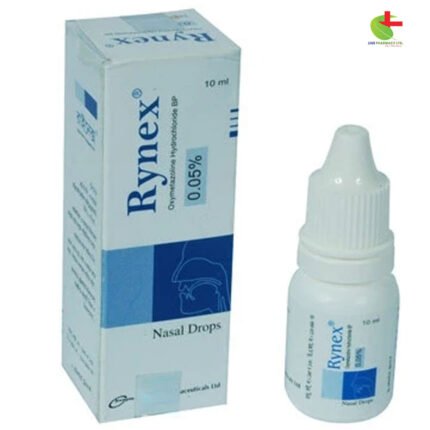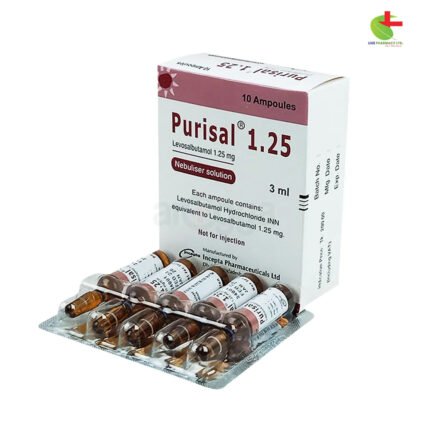Purisal 0.63
15.00৳ Pack
- Purisal Nebuliser Solution is indicated for treating or preventing bronchospasm in patients with reversible obstructive airway disease.
- It contains Levosalbutamol, a selective β2 adrenergic receptor agonist that relaxes airway smooth muscles.
- Administered via nebulization or inhaler, it effectively alleviates asthma symptoms.
- Side effects may include hypokalaemia, palpitations, and muscle tremors, requiring careful monitoring in certain patients.
- Store below 25°C, protecting from light and avoiding refrigeration.
 Brand
Brand
|
Incepta Pharmaceuticals Ltd |
|---|---|
 Generics
Generics
|
Levosalbutamol |
 Type
Type
|
Respirator Solution |
Indications
Purisal Nebuliser Solution and Inhaler are designed to treat and prevent bronchospasm in adults, adolescents, and children suffering from reversible obstructive airway diseases.
Always consult a registered healthcare professional before using this medication.
Pharmacology
Levosalbutamol Nebuliser Solution is a sterile, clear, colorless solution that is free from preservatives. It contains the hydrochloride salt of Levosalbutamol, the (R)-enantiomer of the racemic salbutamol compound. As a selective β2 adrenergic receptor agonist, Levosalbutamol works by activating β2 adrenergic receptors in the airway’s smooth muscle.
The activation of these receptors stimulates adenyl cyclase, resulting in increased intracellular cyclic AMP levels. This rise in cAMP activates protein kinase A, which inhibits myosin phosphorylation and decreases intracellular calcium levels, leading to muscle relaxation. Levosalbutamol effectively relaxes smooth muscles throughout the airways, from the trachea to the terminal bronchioles, serving as a functional antagonist that protects against all bronchoconstrictors, regardless of the underlying spasmogen.
Dosage
Nebuliser Solution: Purisal Nebuliser Solution is provided in unit-dose ampoules and does not require dilution prior to nebulization.
- Children (6 months – 11 years): The recommended dose is 0.31 mg administered three times daily by nebulization. The total daily dose should not exceed 0.63 mg.
- Adults and Adolescents (12 years and older): The initial recommended dose is 0.63 mg administered three to four times daily, every 6 to 8 hours, via nebulization. For those with severe asthma or inadequate response, an increased dosage of 1.25 mg three times a day may be beneficial.
Inhaler: Use your Levosalbutamol Inhaler as needed during an asthma attack at any time, with or without food. Take 1-2 puffs up to four times daily, not exceeding 8 puffs within 24 hours. If your usage exceeds 3-4 times a week, consult your healthcare provider for a medication review. Additionally, to prevent exercise-induced asthma or allergen exposure, use 2 puffs 15 minutes prior to the activity.
Always consult a registered healthcare professional before using this medication.
Administration
While using an inhaler appears straightforward, many patients may not use it correctly. Incorrect usage can limit medication delivery to the lungs. Proper and consistent inhaler use can mitigate or prevent asthma attacks.
Steps for Effective Inhaler Use (as per “National Asthma Guidelines for Medical Practitioners” from the Asthma Association):
- Remove the cap.
- Shake the inhaler vigorously at least six times before each use.
- For a new inhaler or one not used for over a week, shake it well and release one puff into the air to ensure it works.
- Exhale fully and hold the inhaler upright.
- Place the actuator between your teeth and close your lips around the mouthpiece.
- Breathe in deeply and slowly through your mouth while pressing down firmly on the canister to release the medication.
- Remove the inhaler from your mouth and hold your breath for at least 10 seconds or as long as comfortable.
- If prescribed more than one inhalation, wait one minute between puffs, shaking the inhaler well and repeating steps 4 to 7.
- After use, replace the cap on the mouthpiece and rinse your mouth with water.
- Periodically check your technique in front of a mirror; if you see a white mist during inhalation, it indicates a technique error. Repeat from step 4 if needed.
Inhaler Cleaning Instructions: Clean your inhaler at least once a week. Remove the canister and rinse the plastic actuator and cap in warm water, avoiding water on the metal canister. Thoroughly dry the actuator and cap before gently reinserting the metal canister with a twisting motion. Reattach the cap on the mouthpiece.
Always consult a registered healthcare professional before using this medication.
Interaction
Caution is advised when using Purisal with other short-acting sympathomimetic aerosol bronchodilators or epinephrine. If additional adrenergic medications are to be used, monitor closely to avoid adverse cardiovascular effects.
Beta-blockers: These agents may block the effects of beta-agonists like Purisal Nebuliser Solution or Inhaler and may induce severe bronchospasm in asthmatic patients. In specific situations, such as post-myocardial infarction prophylaxis, cardioselective beta-blockers may be used cautiously.
Diuretics: The ECG changes and/or hypokalemia caused by non-potassium sparing diuretics may be aggravated by beta-agonists if dosages exceed recommendations.
Digoxin: Monitor serum digoxin levels in patients receiving both digoxin and Purisal Nebuliser Solution or Inhaler.
Monoamine Oxidase Inhibitors or Tricyclic Antidepressants: Administer Purisal Nebuliser Solution or Inhaler with extreme caution in patients treated with these medications or within two weeks of discontinuation.
Side Effects
Potentially severe hypokalemia may occur due to beta 2-agonist therapy, which can be exacerbated by hypoxia. Additional side effects may include palpitations, fine muscle tremors (especially in the hands), and muscle cramps. Some patients have reported nervousness, headaches, dizziness, fatigue, and insomnia.
Pregnancy & Lactation
Pregnancy: Currently, there are insufficient well-controlled studies on the use of Levosalbutamol Nebuliser Solution in pregnant women. This medication should only be used during pregnancy if the potential benefits justify any potential risks to the fetus.
Lactation: It is unknown if Levosalbutamol is excreted in human milk. Caution is advised when administering Levosalbutamol Nebuliser Solution to nursing mothers.
Precautions & Warnings
Purisal Hydrochloride, like all sympathomimetic amines, should be administered with caution to patients with cardiovascular issues, including coronary insufficiency, hypertension, and arrhythmias; those with convulsive disorders, hyperthyroidism, or diabetes mellitus; and individuals particularly sensitive to sympathomimetics. Purisal Nebuliser Solution or Inhaler must not be injected.
Overdose Effects
Symptoms of overdose primarily involve excessive beta-adrenergic receptor stimulation or exacerbation of listed side effects. Management includes discontinuation of Purisal Nebuliser Solution or Inhaler, along with appropriate symptomatic treatment. The use of a cardioselective beta-receptor blocker may be considered.
Therapeutic Class
Short-acting selective β2-adrenoceptor stimulants
Storage Conditions
Store below 25°C, shielded from light. Do not refrigerate.













Reviews
There are no reviews yet.